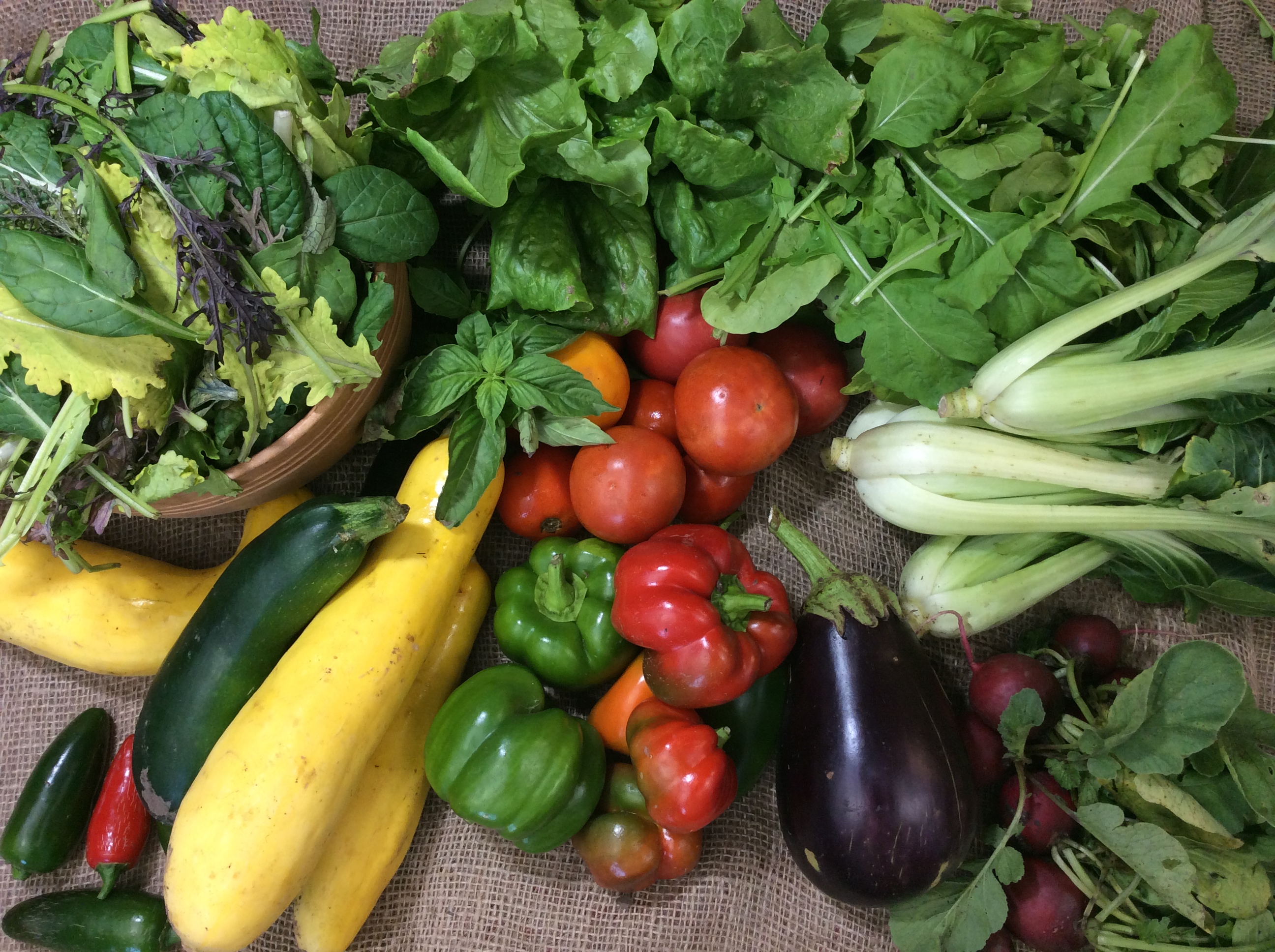Week 20 of the Redfearn Farm CSA includes (beginning in the top left corner of the sample Full share): Stir-fry greens, Lettuce head, Tomatoes with Basil, Arugula, Bok Choy, Radishes, Eggplant (Full Shares Only), Sweet Peppers, Zucchini/ Yellow Squash and Spicy Peppers.
Stir-fry greens mix: Store in plastic bag in refrigerator, use within a couple days. This greens mix contains a variety of mustards, bok choy, and cabbage family greens. Basic cooking instructions: wash and spin dry, slice or chop greens, heat oil (olive or vegetable) over medium-high heat. Gradually add chopped greens, stirring to just wilt. Season with salt and pepper. Variations: add chopped garlic when you add the greens. Top the cooked greens with a fried egg(s). Here’s a detailed sir-fried greens recipe. This recipe for Greens cooked with tomatoes and topped with eggs has helped many people enjoy greens. It is a highly adaptable recipe, and can be used with nearly any type of leafy cooking green, from spicy mustards to mellow chard. Also, some recipes that call for mustard greens can be substituted for this stir fry mix, such as: Indian Saag or Curried Mustard Greens with Kidney Beans.
Lettuce: Store in plastic bag in refrigerator.
Tomatoes: Store at cool room temperature, in a single layer if possible, not in a plastic bag. Here is a website that gives many different Tomato Salad Ideas. This Roasted Tomato Tart recipe is a favorite of mine. Another favorite is baking thick slices with a cheese topping like these Parmesan Tomatoes.
To preserve tomatoes: you can freeze them by cutting out the core and any bad spots and putting them in a freezer bag. To use after freezing: thaw slightly in water and the tomato skin can be easily peeled off. The tomatoes can them be used in soup, sauces or other cooked tomato recipes (after freezing the tomatoes will be very soft, but still have good flavor). You can also dry (sliced) tomatoes in a dehydrator following your dehydrators instructions. Or roast tomatoes until desired dryness and then freeze. Tomatoes can also be canned whole, chopped, as salsas or tomato/ pasta sauce (make sure to follow a recipe that is designed for home canning!).
Here are a few more tomato ideas:
Arugula: store in plastic bag in fridge. This slightly spicy salad green is wonderful in this Roasted Sweet Potato Arugula Salad! Combine arugula with pasta in this Goat Cheese and Arugula over Penne dish. Arugula can also be sautéed in olive oil with some garlic just until wilted. Arugula is great in this Arugula Soup that our whole family enjoys (2 onions can be substituted for the 6 shallots in the recipe, larger potatoes can be used instead of the salad potatoes).
Bok Choy: store in plastic bag in refrigerator. Bok Choy in Garlic Sauce. Cooked (leftover) Bok Choy can be added to fried rice. Bok Choy can also be cooked and used inside egg rolls (I just followed the instructions on the back of the package of egg roll wrappers). Bok choy can be sliced and added to soups during the last few minutes of cooking.
Radishes: a new crop of radishes is ready for harvest! The roots and greens are both very good to eat. Store in plastic bag in refrigerator, the roots separate from the greens. Crisp radishes in ice water. You can just eat them straight with butter and a sprinkle of salt. There are many variations of radish salads, here are a couple: Radish and Mint Salad (I have made variations of this dish and really like it) Smitten Kitchen’s chopped salad. My favorite radish salad is this Rockin’ Radish Salad! Radishes can be sliced and sauteed to reduce their spiciness, or roasted.
Here’s a recipe utilizing both the radish roots and tops: Radish and Radish Top Soup
Eggplant (full shares only): Store in plastic bag in the refrigerator. Eggplant can be sauteed, grilled or roasted. It is great combined with zucchini and tomatoes (such as in Ratatouille).
Sweet peppers: Store in plastic bag, in refrigerator. Meal idea: sauté sliced candy onions and sweet pepper for a tasty Philly Cheese Sandwich . Stuffed peppers are also a favorite main dish at our house; zucchini/ yellow squash can also be stuffed using the same recipe.
Zucchini/ summer squash: store in plastic bag in refrigerator. Zucchini is great sauteed, grilled, eaten raw, or baked into zucchini bread (my kids favorite way to eat zucchini!). Zucchini (sliced and broiled or pan fried) can take the place of pasta in lasagna. If you want more ideas, you can try Baked Zucchini Fries, Squash baked eggs or Zucchini Fritters (these were very good) or Chocolate Zucchini Bread. One of our favorite recipe for a main dish of zucchini is this Cheesy Zucchini Casserole (which we make with shredded sharp cheddar, instead of Velvetta; chopped sweet peppers and sliced fennel can be added to the onion while sautéing ). Here’s a couple other zucchini recipes, recommended by CSA members: Curried Zucchini Soup, Sauteed Zucchini with Cherry Tomatoes (don’t overcook the zucchini!), and Zucchini Chocolate Rum Cake.
To preserve zucchini/ yellow squash: option 1: shred and freeze in freezer bags, to use in zucchini bread or soups or sauces. Option 2: dehydrate in dehydrator until dry like a chip. I usually store in the freezer, if not perfectly dry. Use the dried zucchini in winter soups or sauces (make sure to add them early enough for them to rehydrate).
Hot peppers: Store in plastic bag, in refrigerator. Chop and add to salsa, or use in this Jalapeno Popper Chicken.
If you would like more recipe ideas, I have a pinterest board devoted to CSA vegetable recipes: http://www.pinterest.com/sheriredfearn/csa-veggies-recipes/

